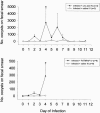Local peroxynitrite formation contributes to early control of Cryptosporidium parvum infection
- PMID: 15972479
- PMCID: PMC1168623
- DOI: 10.1128/IAI.73.7.3929-3936.2005
Local peroxynitrite formation contributes to early control of Cryptosporidium parvum infection
Abstract
In intestinal inflammation, mucosal injury is often exacerbated by the reaction of NO with neutrophil-derived superoxide to form the potent oxidant peroxynitrite. Peroxynitrite also has antimicrobial properties that aid in the killing mechanism of macrophages and neutrophils. Cryptosporidium parvum parasitizes intestinal epithelium, resulting in loss of epithelial cells and mucosal inflammation. Synthesis of NO is significantly increased and arises from the induced expression of inducible nitric oxide synthase (iNOS) by the infected epithelium. Inhibition of iNOS results in intensified epithelial parasitism and oocyst excretion. We hypothesized that formation of peroxynitrite is restricted to sites of iNOS expression by the epithelium and contributes to host defense in C. parvum infection. Accordingly, the location and biological effects of peroxynitrite formation were examined in neonatal piglets infected with C. parvum. Infected piglets were treated daily with a selective iNOS inhibitor [L-N6-(1-iminoethyl)-lysine] or one of two peroxynitrite scavengers [5,10,15,20-tetrakis(N-methyl-4'-pyridyl)porphyrinato iron(III) or uric acid] or received vehicle. At peak infection, peroxynitrite formation was restricted to sites of iNOS expression by parasitized epithelium and lamina propria of the apical villi. Peroxynitrite formation was dependent on iNOS activity and was inhibited by treatment with peroxynitrite scavengers. Scavengers increased the number of intracellular parasites and the number of infected epithelial cells present per villus and significantly exacerbated oocyst excretion. Recovery from infection was not delayed by ongoing treatment with scavenger. The present results are the first to demonstrate an in vivo role for peroxynitrite formation in acute mucosal defense against a noninvasive intestinal epithelial pathogen.
Figures




References
-
- Anand, L., N. G. Brajachand, and C. H. Dhanachand. 1996. Cryptosporidiosis in HIV infection. J. Commun. Dis. 28:241-244. - PubMed
-
- Anonymous. 2000. Outbreak of gastroenteritis associated with an interactive water fountain at a beachside park—Florida, 1999. Morb. Mortal. Wkly. Rep. 49:565-568. - PubMed
-
- Argenzio, R. A., J. A. Liacos, M. L. Levy, D. J. Meuten, J. G. Lecce, and D. W. Powell. 1990. Villous atrophy, crypt hyperplasia, cellular infiltration, and impaired glucose-Na absorption in enteric cryptosporidiosis of pigs. Gastroenterology 98:1129-1140. - PubMed
-
- Banan, A., L. J. Zhang, M. Shaikh, J. Z. Fields, A. Farhadi, and A. Keshavarzian. 2004. Novel effect of NF-κB activation: carbonylation and nitration injury to cytoskeleton and disruption of monolayer barrier in intestinal epithelium. Am. J. Physiol. Cell Physiol. 287:C1139-C1151. - PubMed
-
- Cho, W. S., and C. Chae. 2004. Expression of cyclooxygenase-2 and nitric oxide synthase 2 in swine ulcerative colitis caused by Salmonella typhimurium. Vet. Pathol. 41:419-423. - PubMed
Publication types
MeSH terms
Substances
Grants and funding
LinkOut - more resources
Full Text Sources
Medical

